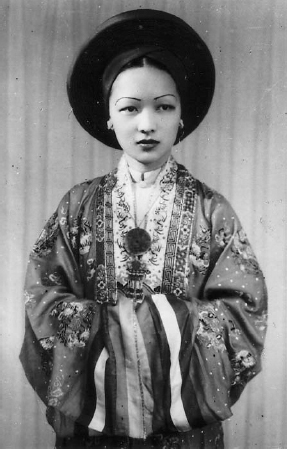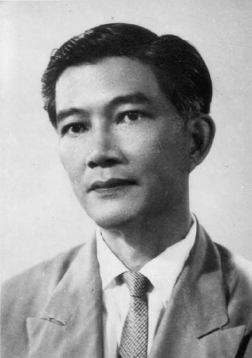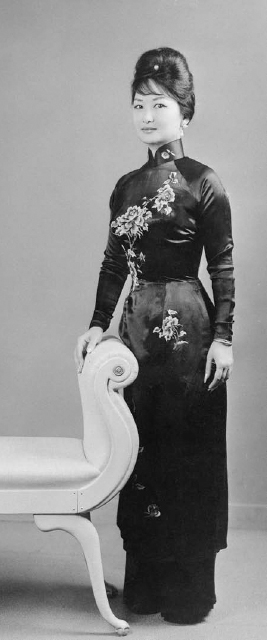Finding the Dragon Lady (21 page)
Read Finding the Dragon Lady Online
Authors: Monique Brinson Demery

Madame Nhu defended her strict laws. “You know, in order to keep the Communists down, you must have a line and stick to it.” She was right. The popular conception of Americans “buying” South Vietnam would be a great recruiting tool for the Communists, and Madame Nhu was sharp enough to see the problem early. But she used a fire
hose to douse a burning match. The people hated her for her imperious manner. Years of colonialism and war had already ground down her countrymen. Madame Nhu liked to talk about representing “her people,” but she barely knew them. Instead, her laws and rules were a bloated extension of her own personal morals and ubiquitous reminders of her power. Her lifestyle in the palace reeked of extravagance and wastefulness when most Vietnamese still lived in the countryside and struggled to get by. She was in no position to deny them a little fun.
Madame Nhu's husband
was no more popular than she was. His position in the Diem administration was loosely defined as chief councilor to the president, but he was largely believed to be the man running the show. To illustrate Nhu's immense power, correspondent David Halberstam tried to superimpose him onto an American context for the readers of the
New York Times:
“Imagine Diem as the President of the United States; in such a situation Nhu would have controlled all the country's newspapers, headed the CIA, the FBI and the Congress, served as the Attorney General and Secretary of State, and written all the reports the President saw. What Diem knew of the outside world was what Nhu wanted him to know; what he saw he saw through Nhu's eyes; the people he met he met only after Nhu had approved them.”
Nhu created different organizations to carry out the political strategies he concocted. There was the Republican Youth, blue-uniform-wearing young men who were supposed to represent the political voice of South Vietnamese youth. Instead of expressing their own political opinions, they mostly parroted the sayings of their founder and leader, Ngo Dinh Nhu. The Republican Youth had 1,386,757 members at the end of 1962, nearly 300,000 down from two years before. The ranks had been purged of any potential Communist saboteurs; 21,061 of the young men had firearms, and they claimed to have killed 234 Communists. Out of their own ranks, they had lost nearly 500 to Communist assassinations and 2,413 more to kidnappings. Those statistics didn't seem to dampen their enthusiasm for their leader. At Nhu's reelection ceremonyâhe had just been voted national chief of the Republican Youth, againâthe vice president of South Vietnam and members of the National Assembly stood by while Nhu received delegates of the
youth corps. Although it rained throughout, Nhu stood, soaking wet, in his official uniform while one by one the youth swore on bended knee to carry out their leader's orders and uphold the Republican Youth constitution, seeking nothing short of mobilizing the entire population of South Vietnam to struggle against the Communists.
14
Another of Nhu's pet projects was the Strategic Hamlets Program. The British had used something like it in Malaya to fight Communist insurgents there. Peasants moved to fortified areas protected by the army, defended by layers of barbed wire, ammunition, and guns. Nhu tried to replicate the British strategy; in theory, strategic hamlets would cut off the Communist access to supplies and manpower. Nhu liked this plan so much because, again, it brought the political revolution out of Saigon and into the rural areas. More than a military tactic to defeat the Communists, it was a logical outgrowth of his social and economic revolution, as well as an opportunity to build a new political base, for Diem, in the countryside. But because of Nhu's quick anger and favoritism, local officials falsely reported strategic hamlets where they didn't in fact exist. They were not exactly cozy settings. The villages were surrounded by booby-trapped bamboo thickets, and two watchtowers looked out into the jungle or rice paddies. Between two fences of barbed wire stood rows of spears, their tips coated with human excrement to infect the wound of any would-be trespasser. But installing barbed wire was time-consuming, and the steel itself was a valuable commodity. Instead of the fourteen tons of barbed wire specified for the construction of each hamlet, ten tons of barbed wire were stretched to build 163 not-very-secure ones. The locals were usually not compensated for loss of land, and people were uprooted at bayonet point without warning from their homes to be relocated because Nhu's strategy was to move into heavy Communist areas without advance notice, preparation, or consent. He made no allowances for the time needed to put other services in place that would have won people over, like security, medical help, and schools. Instead of a pattern of secure villages, Nhu had created what looked like a countryside dotted with small concentration camps.
Most terrifying of all was Nhu's Service for Political and Social Research of the Presidency (SEPES), which was basically an organization
of informers supposed to function like a Vietnamese CIA. The Americans were generous with funding to help it get going. Soon, though, it earned a sinister reputation. SEPES was more than just an intelligence-gathering organization. It meted out justice through special police sections that employed harsh measures. Since it was hard to distinguish between hardcore revolutionaries and patriotically motivated collaborators, both groups were equally persecuted. The men SEPES rounded up could be beaten or given electric shocks to their genitals, but mostly they were just left to languish as political prisoners, making up two-thirds of the 30,000 inmates kept in the tiny nation's fifty jails.
15
Nhu always made sure to defer to his brother, the president, in public, but the perception was increasingly that Nhu was in charge. That made him a target. On a hunting trip to Dalat, the Viet Cong attacked his convoy, and Nhu's head bodyguard was killed in the ambush. The government tried to keep it quiet, presenting the incident as a simple car accident on a dark country road. They never did explain why the car was riddled with bullets.
In an interview with reporter Marguerite Higgins, Nhu was candid about how much people disliked him, “I am hated, and so is my wife,” but he was resigned to his role. “Every government has to have the tough guy, the man who does the dirty and unpleasant work. Even Eisenhower had to have a Sherman Adams [Higgins's footnote: Nhu took great pride in following closely the inner workings of the US government]. . . . In Vietnam, where violence and virulence are everywhere, I am the person who takes on the unpleasant jobs. It is I who am vilified, so that others may be spared.”
16
The popular discontent with Nhu and his lovely wife was well known to the Americans even before Johnson's visit. So why did the vice president make all those rosy promises of American commitment to the regime? As Johnson would explain in an official debrief on the trip, it wasn't that Diem and his family were especially deserving. Diem was complex, remote, and surrounded by people “less admirable and capable.” But the fact remained that there was simply no one else for America to use to hold the line against communism in Southeast Asia. When he was in Saigon, Johnson had gotten a little carried away in the
excitement of the moment and heartily proclaimed Ngo Dinh Diem the Winston Churchill of Asia.
“Did you really mean it?” asked journalist Stanley Karnow.
“Shit,” Johnson drawled in response, “Diem's the only boy we got out there.”
Karnow couldn't print that in the
Saturday Evening Post,
but
New York Times
reporter Homer Bigart had already coined a phrase for the American predicament in Vietnam: “Sink or Swim with Ngo Dinh Diem.” It was the first line of a little song Bigart had made up to be sung among friends in the Saigon press corps to the tune of “I'm an Old Cowhand”:
                                   Â
We must sink or swim
                                   Â
With Ngo Dinh Diem
                                   Â
We will hear no phoo
                                   Â
About Madame Nhu.
                                   Â
Yippee-i-aye, i-aye, etc.
17
On the morning of
February 11, 1962, two dissident pilots swooped low over the palace and dropped their bombs. Their target was the right wing of the palace, where the Nhu family resided. The Chinese nurse of the youngest child was crushed by a falling beam and killed. The Nhus' oldest daughter, Le Thuy, kept a clear head in the chaos. The sixteen-year-old scrambled to save the two youngest children, aged two and not quite ten, when the main stairway collapsed in a fiery crumble.
An entire section of the bedroom floor had given way just as Madame Nhu was running into the bathroom for a dressing gown to put on over her nightgown. She escaped a direct hit but fell two stories onto a pile of iron, wood, and gravel and came to in a heap of smoldering ashes. She would discover that she had three severe third-degree burns and deep lacerations on her arm, but strangely she felt no pain at all. She couldn't feel anything except that it was difficult to move, difficult to pick her way through the mess that had landed on her. But she knew she had to get out of there. A valley of light beckoned; a soft wind blew the smoke away from her. She had never seen so clearly. She saw beyond the ruins. Beyond the long broken shadows of the palace
a brightness was rising. Goodness and Mercy. Staggering toward her was a figure in the flames. It was her husband looking for her, crying out with joy when he found her because he had thought she was dead. All their marriage troubles set aside, they were unitedâat least for the moment. Madame Nhu fainted into her husband's arms.
Madame Nhu lost nearly everything she possessed in the fire. A few dresses that had been at the dressmaker's survived, as did, I would later learn, a diary. Her trophies, the precious tiger skins, were a heap of burned fur. She had only memories left. But to her surprise, she was not despondent. Something new had opened in her, just as it had when she marched across the bridge in central Vietnam as a twenty-one-year-old woman with an infant in her arms. She would profess never to care about something as trivial as clothes or material possessions again.
The photographs of
the women among the tiger skins in Madame Nhu's palace bedroom were made all the more poignant by the coming calamity that would transform the palace into a scene of wreckage.
I pasted each picture carefully into an album, one photograph per page and each page protected by a thin wisp of vellum. The album I had chosen was red, for luck of course. I sent it packed in Styrofoam peanuts by priority mail. In response, she gushed and fawned and praised me. My fulfillment of her challenge was surely a sign of something divine. But she wasn't quite ready yet, she said, to make good on her promise of handing over the memoir. I should be patient, she chided.
Of course
, I should have known better.

F
IGURE 1
. Portrait of Tran Thi Le Xuan as a bride circa 1943

F
IGURE 2
. Portrait of Ngo Dinh Nhu circa 1963

